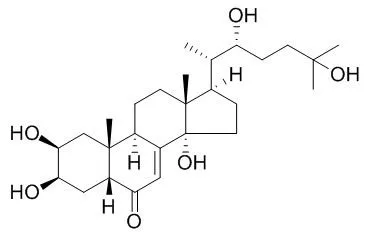| Kinase Assay: |
| Proc Natl Acad Sci U S A. 2015 Feb 3;112(5):1452-7. | | Autocrine regulation of ecdysone synthesis by β3-octopamine receptor in the prothoracic gland is essential for Drosophila metamorphosis.[Pubmed: 25605909] | In Drosophila, pulsed production of the steroid hormone Ecdysone plays a pivotal role in developmental transitions such as metamorphosis. Ecdysone production is regulated in the prothoracic gland (PG) by prothoracicotropic hormone (PTTH) and insulin-like peptides (Ilps).
METHODS AND RESULTS:
Here, we show that monoaminergic autocrine regulation of Ecdysone biosynthesis in the PG is essential for metamorphosis. PG-specific knockdown of a monoamine G protein-coupled receptor, β3-octopamine receptor (Octβ3R), resulted in arrested metamorphosis due to lack of Ecdysone. Knockdown of tyramine biosynthesis genes expressed in the PG caused similar defects in Ecdysone production and metamorphosis. Moreover, PTTH and Ilps signaling were impaired by Octβ3R knockdown in the PG, and activation of these signaling pathways rescued the defect in metamorphosis.
CONCLUSIONS:
Thus, monoaminergic autocrine signaling in the PG regulates Ecdysone biogenesis in a coordinated fashion on activation by PTTH and Ilps. We propose that monoaminergic autocrine signaling acts downstream of a body size checkpoint that allows metamorphosis to occur when nutrients are sufficiently abundant. | | Dev Biol. 2013 Nov 15;383(2):275-84. | | Ecdysone signaling at metamorphosis triggers apoptosis of Drosophila abdominal muscles.[Pubmed: 24051228] | One of the most dramatic examples of programmed cell death occurs during Drosophila metamorphosis, when most of the larval tissues are destroyed in a process termed histolysis. Much of our understanding of this process comes from analyses of salivary gland and midgut cell death. In contrast, relatively little is known about the degradation of the larval musculature.
METHODS AND RESULTS:
Here, we analyze the programmed destruction of the abdominal dorsal exterior oblique muscle (DEOM) which occurs during the first 24h of metamorphosis. We find that Ecdysone signaling through Ecdysone receptor isoform B1 is required cell autonomously for the muscle death. Furthermore, we show that the orphan nuclear receptor FTZ-F1, opposed by another nuclear receptor, HR39, plays a critical role in the timing of DEOM histolysis. Finally, we show that unlike the histolysis of salivary gland and midgut, abdominal muscle death occurs by apoptosis, and does not require autophagy.
CONCLUSIONS:
Thus, there is no set rule as to the role of autophagy and apoptosis during Drosophila histolysis.
|
|
| Animal Research: |
| Dev Biol. 2014 Mar 15;387(2):229-39. | | INO80-dependent regression of ecdysone-induced transcriptional responses regulates developmental timing in Drosophila.[Pubmed: 24468295] | Sequential pulses of the steroid hormone Ecdysone regulate the major developmental transitions in Drosophila, and the duration of each developmental stage is determined by the length of time between Ecdysone pulses. Ecdysone regulates biological responses by directly initiating target gene transcription. In turn, these transcriptional responses are known to be self-limiting, with mechanisms in place to ensure regression of hormone-dependent transcription. However, the biological significance of these transcriptional repression mechanisms remains unclear.
METHODS AND RESULTS:
Here we show that the chromatin remodeling protein INO80 facilitates transcriptional repression of Ecdysone-regulated genes during prepupal development. In ino80 mutant animals, inefficient repression of transcriptional responses to the late larval Ecdysone pulse delays the onset of the subsequent prepupal Ecdysone pulse, resulting in a significantly longer prepupal stage. Conversely, increased expression of ino80 is sufficient to shorten the prepupal stage by increasing the rate of transcriptional repression. Furthermore, we demonstrate that enhancing the rate of regression of the mid-prepupal competence factor βFTZ-F1 is sufficient to determine the timing of head eversion and thus the duration of prepupal development.
CONCLUSIONS:
Although ino80 is conserved from yeast to humans, this study represents the first characterization of a bona fide ino80 mutation in any metazoan, raising the possibility that the functions of ino80 in transcriptional repression and developmental timing are evolutionarily conserved. |
|






 Cell. 2018 Jan 11;172(1-2):249-261.e12. doi: 10.1016/j.cell.2017.12.019.IF=36.216(2019)
Cell. 2018 Jan 11;172(1-2):249-261.e12. doi: 10.1016/j.cell.2017.12.019.IF=36.216(2019) Cell Metab. 2020 Mar 3;31(3):534-548.e5. doi: 10.1016/j.cmet.2020.01.002.IF=22.415(2019)
Cell Metab. 2020 Mar 3;31(3):534-548.e5. doi: 10.1016/j.cmet.2020.01.002.IF=22.415(2019) Mol Cell. 2017 Nov 16;68(4):673-685.e6. doi: 10.1016/j.molcel.2017.10.022.IF=14.548(2019)
Mol Cell. 2017 Nov 16;68(4):673-685.e6. doi: 10.1016/j.molcel.2017.10.022.IF=14.548(2019)